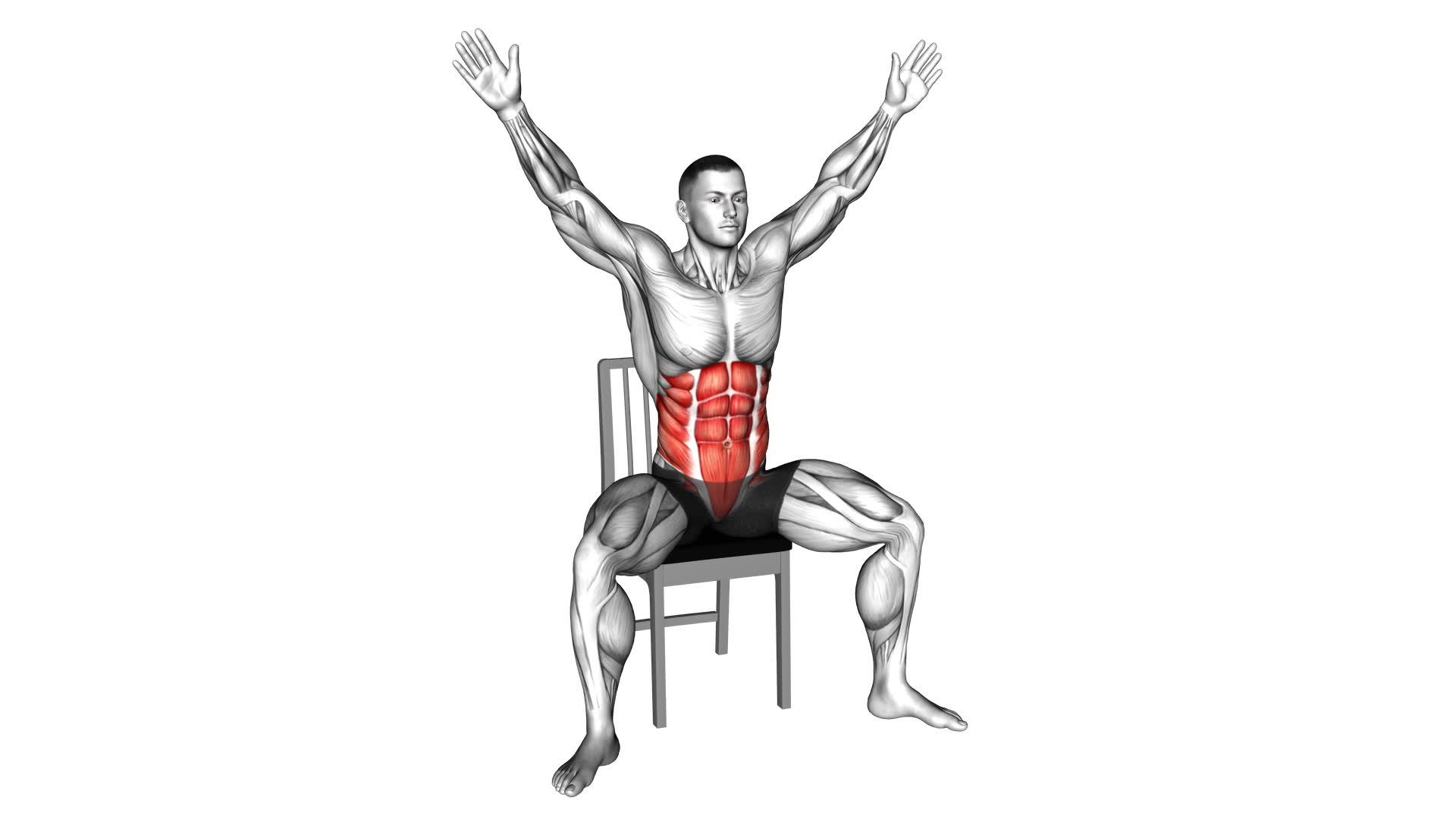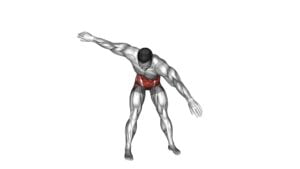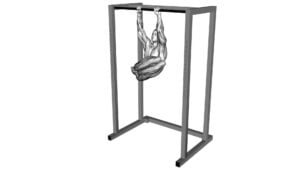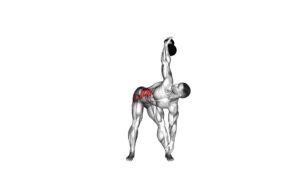Windmill on Chair (male) – Video Exercise Guide & Tips

Are you looking for a challenging exercise to strengthen your core? Look no further than the windmill on chair!
Watch This Exercise Video
This video exercise guide and tips will show you the proper technique and help you avoid common mistakes.
With the right equipment and a little practice, you'll be able to progress and modify this exercise to suit your fitness level.
Get ready to feel the burn and take your core strength to the next level!
Key Takeaways
- Windmill on Chair (male) improves flexibility in hips, shoulders, and hamstrings.
- It enhances range of motion for everyday movements.
- Windmill on Chair (male) builds core strength and stability.
- It helps maintain good posture and enhances athletic performance.
Benefits of Windmill on Chair (male)
You will experience numerous benefits when performing the Windmill on Chair exercise. This exercise is highly effective in improving flexibility and building core strength.
Flexibility is essential for maintaining a healthy and functional body. By regularly practicing the Windmill on Chair, you'll notice an increase in your range of motion, particularly in your hips, shoulders, and hamstrings. This exercise involves rotating your torso while keeping your legs straight and extended, which helps to stretch and elongate the muscles in these areas. As a result, you'll find it easier to perform everyday movements, such as bending down to pick up objects or reaching for things on higher shelves.
In addition to improving flexibility, the Windmill on Chair also targets your core muscles. The rotational movement engages your abdominal muscles, obliques, and lower back, helping to strengthen and stabilize your core. A strong core is vital for maintaining good posture, preventing lower back pain, and enhancing overall athletic performance.
Equipment Needed for Windmill on Chair (Male)
To perform the Windmill on Chair (male) exercise, you'll need a stable and sturdy chair. Here are three essential items to ensure a safe and effective workout:
- Durable Chair: Look for a chair that's sturdy and can support your weight throughout the exercise. It should have a wide base and strong legs to provide stability during the movement.
- Proper Chair Placement: Position the chair on a level surface with enough space around it to allow for full range of motion. Make sure it's placed away from any obstacles or walls to avoid any accidents or injuries.
- Warm Up Exercises: Before attempting the Windmill on Chair (male), it's crucial to warm up your body. Engage in dynamic stretches, such as arm circles and hip rotations, to increase blood flow to the muscles, improve flexibility, and reduce the risk of injury.
Proper Technique for Windmill on Chair (Male)
To properly execute the Windmill on Chair (male) exercise, ensure that you maintain a stable and balanced position on the chair. Start by sitting on the chair with your feet shoulder-width apart and firmly planted on the ground. Place your hands on the sides of the chair, gripping the edges for support. Lean back slightly, engaging your core muscles to keep your body steady.
When performing the Windmill on Chair (male), it's important to maintain proper form throughout the exercise. Keep your back straight and your chest lifted. As you rotate your torso, extend one arm up towards the ceiling while the other arm reaches towards the opposite foot. This twisting motion engages your oblique muscles and increases the challenge of the exercise.
There are variations and modifications that you can incorporate into the Windmill on Chair (male) exercise to suit your fitness level. If you're a beginner, you can start by performing the exercise without any weights or by using a lighter weight. As you progress, you can increase the intensity by using heavier weights or adding a resistance band.
Common Mistakes to Avoid During Windmill on Chair (Male)
To avoid common mistakes during the Windmill on Chair (male) exercise, it's important to maintain proper form and technique. Here are three common mistakes to avoid:
- Rounding your back: One of the most common mistakes is rounding your back during the exercise. This not only puts unnecessary strain on your spine but also reduces the effectiveness of the exercise. To prevent this, focus on keeping your back straight and your core engaged throughout the movement.
- Using momentum: Another mistake is relying on momentum rather than using controlled movements. Swinging your body or using jerky motions can lead to injury and prevent you from targeting the intended muscles. Instead, concentrate on performing the exercise slowly and smoothly, focusing on engaging the correct muscles.
- Neglecting proper breathing: Breathing is often overlooked, but it plays a crucial role in maintaining proper form and maximizing the benefits of the exercise. It's important to inhale deeply before starting the movement and exhale as you lower your body. This helps stabilize your core and maintain control throughout the exercise.
Tips for Progressing and Modifying Windmill on Chair (Male)
Modify the Windmill on Chair (male) exercise by incorporating additional resistance or increasing the range of motion. To progress this exercise and challenge your muscles further, you can gradually increase the amount of weight you use. Start by using a lighter weight and gradually increase it as you become stronger and more comfortable with the movement. This will help to build strength and muscle endurance in your shoulders, core, and upper back.
Another way to progress the Windmill on Chair exercise is by increasing the range of motion. Start by performing the exercise with a smaller range of motion and gradually increase it as you become more flexible and confident in the movement. This won't only challenge your muscles in different ways but also improve your flexibility and mobility.
To add variation to the Windmill on Chair exercise, you can also try performing it on different types of chairs or using different props. For example, you can use a stability ball instead of a chair or perform the exercise on a yoga block to increase the instability and challenge your core muscles even more.
Remember to always listen to your body and progress at your own pace. It's important to maintain proper form and technique throughout the exercise to prevent injury and get the most out of your workout.
Frequently Asked Questions
How Does the Windmill on Chair (Male) Exercise Benefit the Lower Body?
The windmill on chair exercise is a great way to strengthen your lower body. By incorporating chair exercises for seniors, it provides a stable surface for support and reduces the risk of injury.
The windmill motion engages your leg muscles, including the quadriceps, hamstrings, and glutes. It also improves balance and flexibility.
To modify the exercise, you can start with smaller motions and gradually increase your range of motion as you build strength and stability.
Can the Windmill on Chair (Male) Exercise Help Improve Balance and Stability?
Yes, the windmill on chair (male) exercise can help improve balance and stability. By engaging the lower body muscles, this exercise challenges your core stability and forces you to maintain control throughout the movement.
To modify the exercise, you can start with smaller movements or use a lower chair. For advanced users, variations such as adding weights or performing the exercise on an unstable surface can further enhance balance and stability.
What Muscles Does the Windmill on Chair (Male) Exercise Primarily Target?
The windmill on chair (male) exercise primarily targets the core muscles, including the obliques and rectus abdominis. Additionally, it engages the muscles in the shoulders, back, and hips.
To add variation to this exercise, you can incorporate weights or resistance bands to increase the intensity. Another option is to perform the exercise on an unstable surface, such as a balance board, to challenge your balance and stability even further.
Is the Windmill on Chair (Male) Exercise Suitable for Beginners?
The windmill on chair (male) exercise can be suitable for beginners with the right modifications. It's important to start with a lighter weight and focus on proper form to avoid injury.
If the windmill on chair (male) is too challenging, there are alternative exercises that can target similar muscles, such as the standing side bend or the seated Russian twist.
Always listen to your body and consult a professional if you have any concerns.
Can the Windmill on Chair (Male) Exercise Be Performed Without Any Equipment?
Yes, you can perform the windmill on chair (male) exercise without any equipment.
This exercise is a great way to strengthen your core and improve flexibility. By using just your body weight and a chair, you can engage your abdominal muscles, obliques, and lower back.
It also helps to improve balance and coordination. There are different variations of the windmill exercise that you can try to target different muscle groups and increase the challenge.
Conclusion
In conclusion, the windmill on chair exercise is a beneficial workout for men that targets the core muscles and improves stability. With the proper technique and equipment, this exercise can be performed effectively.
It's important to avoid common mistakes and follow the tips for progressing and modifying the exercise to ensure safety and maximize results. Incorporating the windmill on chair into your fitness routine can help enhance overall strength and flexibility.

Author
Years ago, the spark of my life’s passion ignited in my mind the moment I stepped into the local gym for the first time. The inaugural bead of perspiration, the initial endeavor, the very first surge of endorphins, and a sense of pride that washed over me post-workout marked the beginning of my deep-seated interest in strength sports, fitness, and sports nutrition. This very curiosity blossomed rapidly into a profound fascination, propelling me to earn a Master’s degree in Physical Education from the Academy of Physical Education in Krakow, followed by a Sports Manager diploma from the Jagiellonian University. My journey of growth led me to gain more specialized qualifications, such as being a certified personal trainer with a focus on sports dietetics, a lifeguard, and an instructor for wellness and corrective gymnastics. Theoretical knowledge paired seamlessly with practical experience, reinforcing my belief that the transformation of individuals under my guidance was also a reflection of my personal growth. This belief holds true even today. Each day, I strive to push the boundaries and explore new realms. These realms gently elevate me to greater heights. The unique combination of passion for my field and the continuous quest for growth fuels my drive to break new ground.



